Abstract
An in vitro osteolysis assay with 45Ca-labelled mouse calvaria has been used to investigate mechanisms of direct bone invasion by squamous carcinomas of the head and neck. Short-term (3-day) organ cultures of 8 fresh squamous carcinomas showed varying degrees of in vitro bone-resorbing activity which was blocked by indomethacin, an inhibitor of prostaglandin synthesis. Supernatant media from 6 established cell lines also induced bone resorption in vitro and evoked an osteoclastic response in the cultured calvaria. Osteolysis by supernatant media was not blocked by indomethacin in all the tumour-cell lines, and the production of non-prostaglandin osteolysins by the indomethacin-resistant lines is postulated. The two principal findings that emerge are: (1) Stimulants for osteoclastic activity are derived from both squamous-carcinoma cells and from host cells in the tumour stroma. (2) These stimulants are diverse. Indomethacin-sensitive agents, presumed to be prostaglandins, are most convincingly demonstrated in the fresh tumours. Indomethacin-resistant agents, presumably not prostaglandins, are more characteristic of the carcinoma cell lines.
Similar content being viewed by others
Rights and permissions
About this article
Cite this article
Tsao, S., Burman, J., Easty, D. et al. Some mechanisms of local bone destruction by squamous carcinomas of the head and neck. Br J Cancer 43, 392–401 (1981). https://doi.org/10.1038/bjc.1981.60
Issue Date:
DOI: https://doi.org/10.1038/bjc.1981.60
- Springer Nature Limited
This article is cited by
-
Cell, tissue and organ culture as in vitro models to study the biology of squamous cell carcinomas of the head and neck
Cancer and Metastasis Review (1996)




